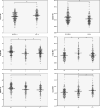White matter disruptions in patients with bipolar disorder
- PMID: 29779901
- PMCID: PMC6008233
- DOI: 10.1016/j.euroneuro.2018.01.001
White matter disruptions in patients with bipolar disorder
Abstract
Bipolar disorder (BD) patients show aberrant white matter microstructure compared to healthy controls but little is known about the relation with clinical characteristics. We therefore investigated the relation of white matter microstructure with the main pharmacological treatments as well its relation with IQ. Patients with BD (N = 257) and controls (N = 167) underwent diffusion tensor imaging (DTI) and comprehensive clinically assessments including IQ estimates. DTI images were analyzed using tract-based spatial statistics. Fractional anisotropy (FA) and Mean Diffusivity (MD) were determined. Patients had significantly lower FA and higher MD values throughout the white matter skeleton compared to controls. Within the BD patients, lithium use was associated with higher FA and lower MD. Antipsychotic medication use in the BD patients was not associated with FA but, in contrast to lithium, was associated with higher MD. IQ was significantly positively correlated with FA and negatively with MD in patients as well as in controls. In this large DTI study we found evidence for marked differences in FA and MD particularly in (but not restricted to) corpus callosum, between BD patients and controls. This effect was most pronounced in lithium-free patients, implicating that lithium affects white matter microstructure and attenuates differences associated with bipolar disorder. Effects of antipsychotic medication intake were absent in FA and only subtle in MD relative to those of lithium. The abnormal white matter microstructure was associated with IQ but not specifically for either group.
Keywords: Antipsychotic medication; Bipolar disorder; Diffusion-weighted imaging; IQ; Lithium; TBSS.
Copyright © 2018 Elsevier B.V. and ECNP. All rights reserved.
Conflict of interest statement
The authors confirm that there are no known conflicts of interest associated with this publication and there has been no significant financial support for this work that could have influenced its outcome
Figures



Similar articles
-
Diffusion tensor imaging in euthymic bipolar disorder - A tract-based spatial statistics study.J Affect Disord. 2016 Oct;203:281-291. doi: 10.1016/j.jad.2016.05.040. Epub 2016 Jun 1. J Affect Disord. 2016. PMID: 27317921
-
Reduced white matter integrity and verbal fluency impairment in young adults with bipolar disorder: a diffusion tensor imaging study.J Psychiatr Res. 2015 Mar;62:115-22. doi: 10.1016/j.jpsychires.2015.01.008. Epub 2015 Feb 7. J Psychiatr Res. 2015. PMID: 25684152 Free PMC article.
-
Changes in white matter microstructure predict lithium response in adolescents with bipolar disorder.Bipolar Disord. 2017 Nov;19(7):587-594. doi: 10.1111/bdi.12544. Epub 2017 Oct 9. Bipolar Disord. 2017. PMID: 28992395
-
Shared and Distinct White Matter Alterations in Major Depression and Bipolar Disorder: A Systematic Review and Meta-Analysis.J Integr Neurosci. 2024 Sep 19;23(9):170. doi: 10.31083/j.jin2309170. J Integr Neurosci. 2024. PMID: 39344242
-
Association of increased genotypes risk for bipolar disorder with brain white matter integrity investigated with tract-based spatial statistics: Special Section on "Translational and Neuroscience Studies in Affective Disorders". Section Editor, Maria Nobile MD, PhD. This Section of JAD focuses on the relevance of translational and neuroscience studies in providing a better understanding of the neural basis of affective disorders. The main aim is to briefly summarise relevant research findings in clinical neuroscience with particular regards to specific innovative topics in mood and anxiety disorders.J Affect Disord. 2017 Oct 15;221:312-317. doi: 10.1016/j.jad.2017.06.031. Epub 2017 Jun 15. J Affect Disord. 2017. PMID: 28648753 Review.
Cited by
-
Neuroimaging Studies of Brain Structure in Older Adults with Bipolar Disorder: A Review.J Psychiatr Brain Sci. 2022;7(4):e220006. doi: 10.20900/jpbs.20220006. Epub 2022 Aug 25. J Psychiatr Brain Sci. 2022. PMID: 36092855 Free PMC article.
-
Exploring lithium's transcriptional mechanisms of action in bipolar disorder: a multi-step study.Neuropsychopharmacology. 2020 May;45(6):947-955. doi: 10.1038/s41386-019-0556-8. Epub 2019 Oct 25. Neuropsychopharmacology. 2020. PMID: 31652432 Free PMC article.
-
Widespread intra-axonal signal fraction abnormalities in bipolar disorder from multicompartment diffusion MRI: Sensitivity to diagnosis, association with clinical features and pharmacologic treatment.Hum Brain Mapp. 2023 Aug 15;44(12):4605-4622. doi: 10.1002/hbm.26405. Epub 2023 Jun 26. Hum Brain Mapp. 2023. PMID: 37357976 Free PMC article.
-
White matter integrity in young medication-naïve bipolar II depressed adults.Sci Rep. 2021 Jan 19;11(1):1816. doi: 10.1038/s41598-021-81355-9. Sci Rep. 2021. PMID: 33469064 Free PMC article.
-
White Matter Microstructure in Individuals With and At Risk for Bipolar Disorder: Evidence for an Endophenotype From a Voxel-Based Meta-analysis.Biol Psychiatry Cogn Neurosci Neuroimaging. 2020 Dec;5(12):1104-1113. doi: 10.1016/j.bpsc.2020.06.007. Epub 2020 Jun 20. Biol Psychiatry Cogn Neurosci Neuroimaging. 2020. PMID: 32839153 Free PMC article.
References
-
- Abramovic L, Boks MP, Vreeker A, Bouter DC, Kruiper C, Verkooijen S, van Bergen AH, Ophoff RA, Kahn RS, van Haren NEM. The association of antipsychotic medication and lithium with brain measures in patients with bipolar disorder. European Neuropsychopharmacology. 2016;26:1741–1751. - PubMed
-
- Andersson JL, Jenkinson M, Smith S. Non-linear optimisation FMRIB technical report TR07JA1. 2007a from www.fmrib.ox.ac.uk/analysis/techrep.
-
- Andersson JL, Jenkinson M, Smith S. Non-linear registration, aka Spatial normalisation FMRIB technical report TR07JA2 FMRIB Analysis Group of the University of Oxford. 2007b:2.
-
- Azim K, Butt AM. GSK3β negatively regulates oligodendrocyte differentiation and myelination in vivo. Glia. 2011;59:540–553. - PubMed
Publication types
MeSH terms
Substances
Grants and funding
LinkOut - more resources
Full Text Sources
Other Literature Sources
Medical

